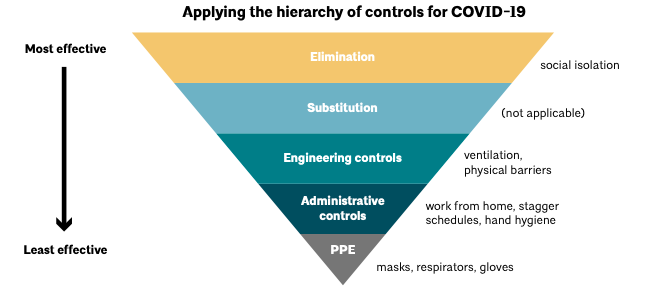The American Institute of Architects (AIA) is releasing a new Re-occupancy Assessment Tool today that provides strategies for limiting exposure to COVID-19 in buildings.
"Design is a response to the conditions, needs and functions of our society,” said AIA 2020 President Jane Frederick, FAIA. “This may be the most pivotal and defining moment in our lifetime for design. Architects are needed in this crisis to help safely transition our communities back to offices, schools and the many other places that are important in shaping our daily lives.”
AIA’s Disaster Assistance Committee developed the Re-occupancy Assessment Tool to provide public officials, businesses and architects with practices that protect the health, safety and welfare of the public while businesses, stores, restaurants, etc., reopen. The tool provides a framework of strategies and general mitigation measures that can help reduce exposure to COVID-19.
Using credible science, a multi-disciplinary team of architects, public health experts, engineers, product designers, and facility managers will evaluate behavioral, spatial, material and operational strategies to customize the tool for a variety of building types, including:
• offices;
• schools (K-12);
• multi-unit dwellings;
• retail establishments, restaurants; and
• senior care facilities.
Findings will be released in phases as they become available, with a priority focused on strategies that address immediate needs. Long-term strategies will also be developed for making buildings more resilient in the face of pandemics, natural hazards, climate change and other risks.
Visit AIA’s website for more COVID-19 resources for architects.
Related Stories
Multifamily Housing | Jun 29, 2023
5 ways to rethink the future of multifamily development and design
The Gensler Research Institute’s investigation into the residential experience indicates a need for fresh perspectives on residential design and development, challenging norms, and raising the bar.
Office Buildings | Jun 28, 2023
When office-to-residential conversion works
The cost and design challenges involved with office-to-residential conversions can be daunting; designers need to devise creative uses to fully utilize the space.
Arenas | May 18, 2023
How can we reimagine live sports experiences?
A Gensler survey finds what sports fans' experiences have been like returning to arenas, and their expectations going forward.
Headquarters | May 15, 2023
The new definition of Class A property
Dan Cheetham, Managing Director and Founder of FYOOG, believes organizations returning to a "hub and spoke" model could have a profound effect on properties once considered Class B.
Office Buildings | May 5, 2023
9 workplace design trends for 2023
HOK Director of WorkPlace Kay Sargent and Director of Interiors Tom Polucci discuss the trends shaping office design in 2023.
Multifamily Housing | Apr 4, 2023
Acing your multifamily housing amenities for the modern renter
Eighty-seven percent of residents consider amenities when signing or renewing a lease. Here are three essential amenity areas to focus on, according to market research and trends.
Urban Planning | Mar 16, 2023
Three interconnected solutions for 'saving' urban centers
Gensler Co-CEO Andy Cohen explores how the global pandemic affected city life, and gives three solutions for revitalizing these urban centers.
Laboratories | Mar 9, 2023
5 laboratory design choices that accelerate scientific discovery
Stephen Blair, director of CannonDesign's Science & Technology Practice, identifies five important design strategies to make the most out of our research laboratories.
Augmented Reality | Jan 27, 2023
Enhancing our M.O.O.D. through augmented reality therapy rooms
Perkins Eastman’s M.O.O.D. Space aims to make mental healthcare more accessible—and mental health more achievable.
K-12 Schools | Nov 30, 2022
School districts are prioritizing federal funds for air filtration, HVAC upgrades
U.S. school districts are widely planning to use funds from last year’s American Rescue Plan (ARP) to upgrade or improve air filtration and heating/cooling systems, according to a report from the Center for Green Schools at the U.S. Green Building Council. The report, “School Facilities Funding in the Pandemic,” says air filtration and HVAC upgrades are the top facility improvement choice for the 5,004 school districts included in the analysis.

















